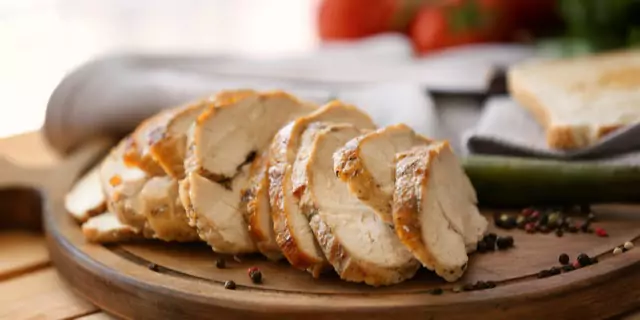How to Eat Your Thanksgiving Dinner This Year

Key Takeways
Turkey Day is just around the corner, and you’re probably already drooling over the thought of a scrumptious roast with all the trimmings. Thanksgiving is a time to enjoy some quality time with family, friends, and loved ones and to share a communal meal that brings everyone a little closer together.
But for some, it’s a veritable landmine of stuffing, pie, and buttery mashed potatoes compounded by the fact that you’re likely to be a football-watching couch potato all day. This means it’s also a stressful time, especially if you’re anticipating glucose spikes or trying to ensure you stay healthy without sacrificing all of the celebratory food.
But it doesn’t have to be! We’re here to help, so think of this as a quick Thanksgiving Glucose Guide.
A Healthier Way to Approach Your Thanksgiving Meal
Don’t get us wrong—Thanksgiving is just one day out of the 365 days that you have to optimize your glucose. So it’s not the end of the world to have a couple of carb-laden meals. But the name of the game is optimizing, and we know that if you’re reading this, you care about your glucose values and want to make sure they stay in a healthy range most of the time.
We want to help you eat this meal so that your glucose levels will thank you. Because at the end of the day, food should be both nourishing and enjoyable. Here are a few easy steps to having your best Thanksgiving meal yet.
#1: Meal Sequencing Matters

As studies consistently show, the order in which you eat does matter when it comes to your glucose levels. If you haven’t read our article about meal sequencing yet, check that out. In a nutshell: try to eat your protein and fiber first. Protein helps to slow down the rise in glucose, sort of like adding a big log to a fire that will burn for hours versus throwing a piece of paper on a fire that will burn up too quickly.
Additionally, filling up on fiber-rich foods like vegetables or nuts can help with satiety. Vegetables also take more time to chew and digest, which can help curb overeating. Practicing some meal sequencing during your Thanksgiving dinner can help keep your glucose levels in check.
A few options to experiment with:
- Try to eat a small amount of protein about 15-30 minutes before your Thanksgiving meal. This could be a hard-boiled egg, a bit of turkey, a handful of nuts, or some cheese from a charcuterie board or appetizer tray. This works in two ways: You won’t be ravenous and tempted to overeat by the main course, and your glucose will be less likely to spike drastically from the carbohydrates.
- If you’re holding out for your main meal, try to eat your turkey and roasted vegetables first, and then dig into the stuffing and mashed potatoes.
#2: Consider How to Build Your Plate

Typically, you want to aim to fill half your plate with non-starchy vegetables (like salad and roasted vegetables). Thanksgiving meals include a variety of foods based on different traditions, so this will look different for everyone.
From there, fill a quarter of your plate with protein (yes, the turkey!) and the other quarter with starchy carbohydrate sources (sweet potato casserole, stuffing, green bean casserole, dinner rolls, mashed potatoes, and so on). Consider adding a new dish to your Thanksgiving table this year if you’re missing out on any of these foods.
If you’re trying to stick to a certain carbohydrate amount per meal, here's a quick reference of average carbohydrate counts for a few Thanksgiving favorites:

#3: Be Mindful

You get to decide what’s most important in terms of what ends up on your Thanksgiving plate. Do you dream about your Aunt Ellen’s mashed potatoes but feel “meh” about the cranberry sauce? Grab what you love and leave what you don’t. You may get a sense of FOMO (fear of missing out) when it comes to a celebratory meal and feel almost like you need to eat everything just to make the most of it.
But it’s best to be choosy here. This will ensure you truly enjoy your meal instead of wondering why you ate a second helping of green bean casserole when you don’t even really like it. And, you’ll have more room for pie!
In the same way, decide to be mindful about your alcohol intake. Too much, and inhibitions (and decision-making skills) can become impaired, which may lead you to indulge a bit more than you should. It’s a good idea to pause, take a few deep breaths and then continue your meal so you can focus on intentionality rather than mindless munching.
#4: When in Doubt, Sub it Out

Okay, so you don’t have to swap out all your mashed potatoes for mashed cauliflower, but try mixing a little in to see what happens—healthy alternatives can surprise you! If you’re wondering what else you can swap out without sacrificing on the taste, here are some of our nutritionist Elizabeth McKinney’s favorite glucose hacks:
- Use monk fruit sweetener in your pies and cranberry sauce.
- Try doing a 50/50 split between mashed cauliflower and mashed potatoes (you’ll be surprised how hard it is to tell the difference).
- Choose whole wheat instead of white bread rolls.
- Substitute candied yams for a glucose-friendly Butternut Squash Casserole or these Butternut Squash Oven Fries.
#5: Slow Down

Meals containing a large amount of fat and carbohydrates can make you feel too full. This will lead to glucose hanging around in your bloodstream for longer than is ideal due to how fat delays digestion.
An excellent way to combat this is to try eating a small portion or first helping, then waiting for around 20 minutes before getting seconds. It takes 20 minutes from the time you start eating for the satiety signal to reach your brain and tell you you’re full.
Eating slowly will help you notice when you begin to feel full, which can help you avoid overeating, or that dreaded post-Thanksgiving food coma.
#6: Don’t Be a Couch Potato

Remember that your muscles are huge sinks for glucose, and this is the first place glucose will be stored after a meal. Sitting on the couch after a big meal means you're not getting any movement, so there are not many places for your glucose to go!
Try taking the dog for a walk, or spending some time outdoors after dinner. Here are some more great ways to open up some glucose storage space on Thanksgiving:
- Play charades after dinner! Even just standing up versus sitting down has a significant impact on your glucose use and insulin sensitivity.
- Make movement fun! Run a family 5k together on Thanksgiving morning.
- Take a family walk around your neighborhood.
- Get a touch football game going in the yard.
Find the right Nutrisense programto turn insight into progress.
Go Beyond Glucose Data with Nutrisense
Your glucose can significantly impact how your body feels and functions. That’s why stable levels are an important factor in supporting overall wellbeing. But viewing glucose isn't enough. Nutrisense, you’ll be able to learn how to use your body's data to make informed lifestyle choices that support healthy living.
One-to-one coaching
Sign up to access insurance-covered video calls to work with a glucose expert: a personal registered dietitian or certified nutritionist who will help tailor your lifestyle and diet to your goals.
Monitor and measure what matters
With the Nutrisense CGM Program, you can monitor your glucose with health tech like glucose biosensors and continuous glucose monitor (CGM)s, and analyze the trends over time with the Nutrisense App. This will help you make the most informed choices about the foods you consume and their impact on your health.
Find your best fit
Ready to take the first step? Start with our quiz to find the right Nutrisense program to help you take control.

Kara Collier is a registered dietitian nutritionist and certified nutrition support clinician who is passionate about reshaping how we approach prevention, behavior change, and metabolic health. A Forbes 30 Under 30 honoree, she’s helped over 150,000 people improve their metabolic health using tools like continuous glucose monitors and behavior-focused nutrition strategies. Kara has been featured by Forbes, UC Berkeley, and HLTH, and has appeared on top podcasts like Mind Pump and The Genius Life.




.jpeg)